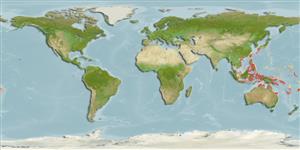Actinopterygii (peixes com raios nas barbatanas) >
Perciformes (Perch-likes) >
Blenniidae (Combtooth blennies) > Blenniinae
Etymology: Omobranchus: Greek, omo = shoulder + Greek, brangchia = gill (Ref. 45335).
Ambiente / Clima / Intervalo
Ecologia
; marinhas associadas(os) a recifes; intervalo de profundidade 0 - 3 m (Ref. 90102). Tropical, preferred ?
Western Pacific: Taiwan and Hong Kong to New Caledonia (Ref. 40966).
Tamanho / Peso / Idade
Maturity: Lm ? range ? - ? cm
Max length : 8.0 cm TL macho/indeterminado; (Ref. 36661)
Espinhos dorsais (total): 12 - 14; Raios dorsais moles (total): 18-23; Espinhos anais 2; Raios anais moles: 21 - 26. Head with wavy vertical lines, pale-rimmed dark spot just behind eye, oblique brownish bands, and curved white lines on side. Dorsal rays usually XIII, fin slightly notched between spinous and soft portions; 3 mandibular pores on each side; gill opening extending ventrally from slightly above pectoral-fin base to opposite 6th pectoral ray; head crest and cirri absent; last dorsal and anal rays attached by membrane to caudal fin; body depth about 5.8 in SL. Maximum size to 7.8 cm TL (Ref. 90102).
Adults inhabit shallow reefs, in crevices just below level of low tide (Ref. 36661). Found in tidepools and rocky shores, solitary or in small groups (Ref. 90102). Oviparous. Eggs are demersal and adhesive (Ref. 205), and are attached to the substrate via a filamentous, adhesive pad or pedestal (Ref. 94114). Larvae are planktonic, often found in shallow, coastal waters (Ref. 94114).
Life cycle and mating behavior
Maturidade | Reprodução | Desova | Ovos | Fecundidade | Larvas
Oviparous, distinct pairing (Ref. 205).
Allen, G.R., 1997. The marine fishes of tropical Australia and south-east Asia. Western Australian Museum, Perth, Western Australia. 292 p. (Ref. 36661)
Categoria na Lista Vermelha da IUCN (Ref. 115185)
Can't connect to MySQL database (fbapp). Errorcode: Too many connections
